Information Systems Management Strategies: Nestle, Ferrari, and More
VerifiedAdded on 2023/05/30
|17
|4054
|192
Report
AI Summary
This report critically examines the application of information systems and information technology in four prominent global organizations: Nestle, Ferrari, Accenture, and Cognizant. It delves into the specific strategies each company employs, such as Nestle's use of SAP solutions for global standardization, Accenture's focus on future-proof IT solutions, Cognizant's implementation of AI and cloud technologies, and Ferrari's integration of innovative information systems. The report highlights success factors, lessons learned, and provides recommendations for improvement for each organization, covering aspects from resource management and product innovation to employee satisfaction and data security. Internal and external factors influencing innovation are also analyzed, offering a comprehensive overview of the strategic use of information systems in driving organizational success and addressing challenges within the dynamic IT landscape. The report is a comprehensive study for students, offering insights into the practical application of information systems in the business world.
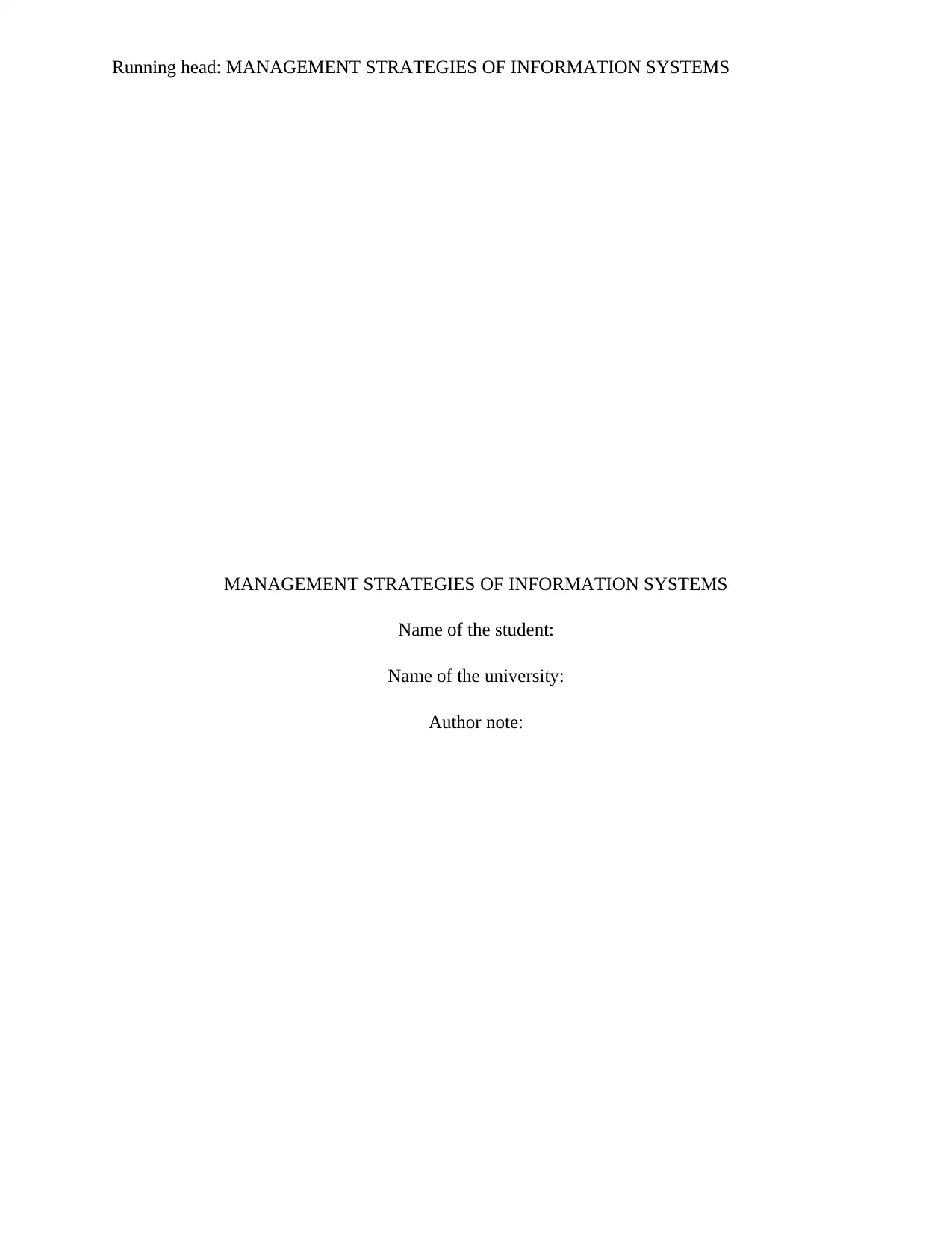
Running head: MANAGEMENT STRATEGIES OF INFORMATION SYSTEMS
MANAGEMENT STRATEGIES OF INFORMATION SYSTEMS
Name of the student:
Name of the university:
Author note:
MANAGEMENT STRATEGIES OF INFORMATION SYSTEMS
Name of the student:
Name of the university:
Author note:
Secure Best Marks with AI Grader
Need help grading? Try our AI Grader for instant feedback on your assignments.
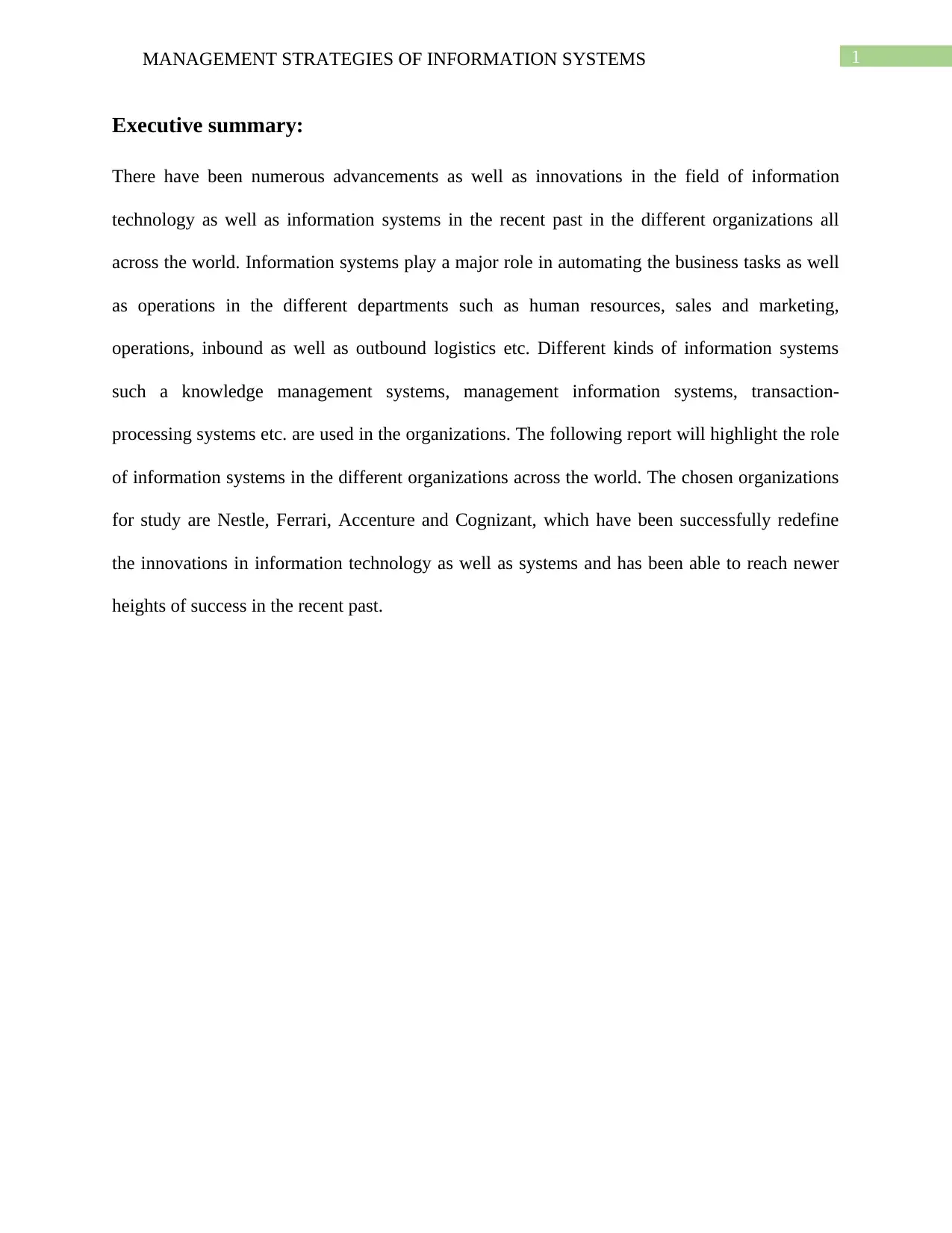
1MANAGEMENT STRATEGIES OF INFORMATION SYSTEMS
Executive summary:
There have been numerous advancements as well as innovations in the field of information
technology as well as information systems in the recent past in the different organizations all
across the world. Information systems play a major role in automating the business tasks as well
as operations in the different departments such as human resources, sales and marketing,
operations, inbound as well as outbound logistics etc. Different kinds of information systems
such a knowledge management systems, management information systems, transaction-
processing systems etc. are used in the organizations. The following report will highlight the role
of information systems in the different organizations across the world. The chosen organizations
for study are Nestle, Ferrari, Accenture and Cognizant, which have been successfully redefine
the innovations in information technology as well as systems and has been able to reach newer
heights of success in the recent past.
Executive summary:
There have been numerous advancements as well as innovations in the field of information
technology as well as information systems in the recent past in the different organizations all
across the world. Information systems play a major role in automating the business tasks as well
as operations in the different departments such as human resources, sales and marketing,
operations, inbound as well as outbound logistics etc. Different kinds of information systems
such a knowledge management systems, management information systems, transaction-
processing systems etc. are used in the organizations. The following report will highlight the role
of information systems in the different organizations across the world. The chosen organizations
for study are Nestle, Ferrari, Accenture and Cognizant, which have been successfully redefine
the innovations in information technology as well as systems and has been able to reach newer
heights of success in the recent past.
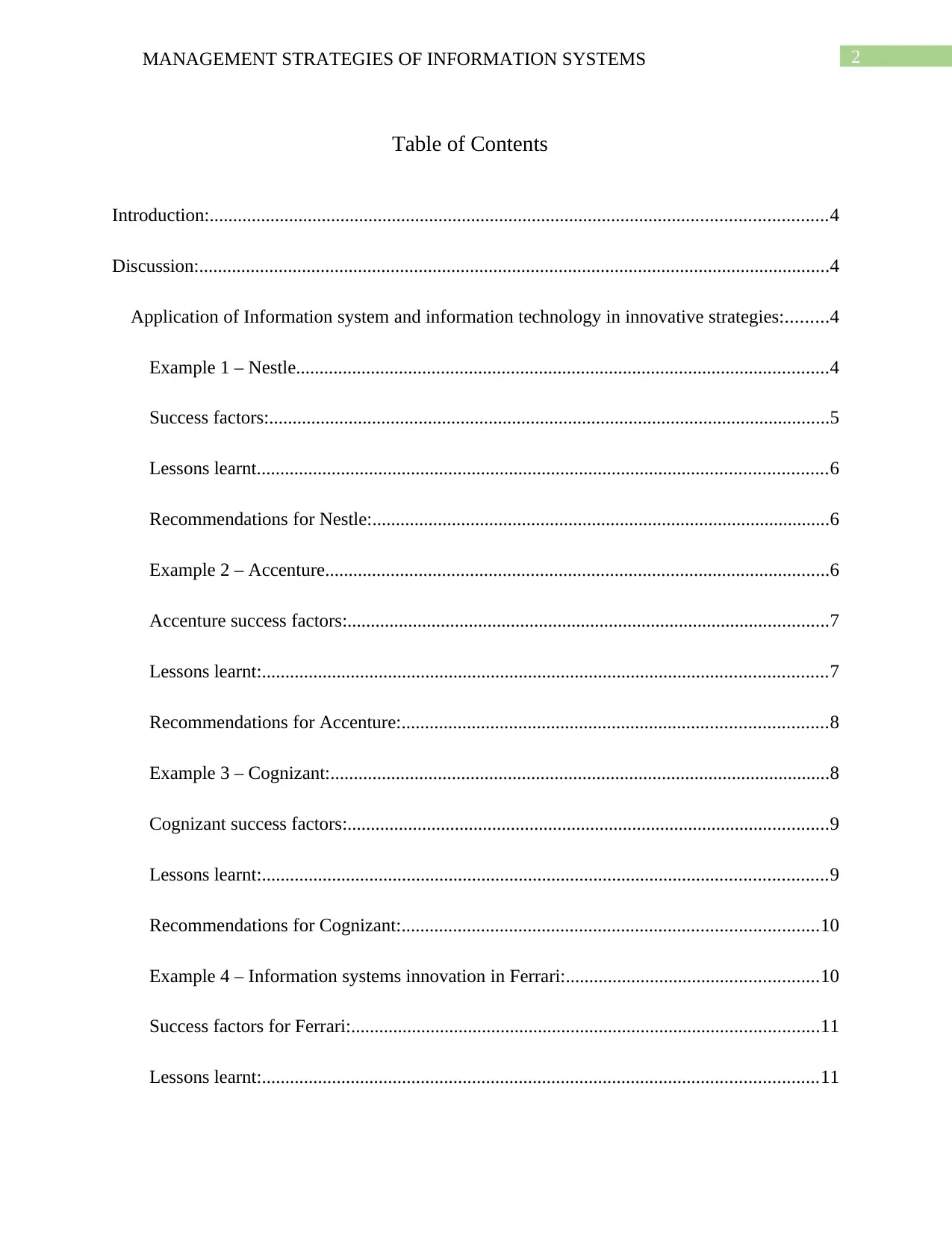
2MANAGEMENT STRATEGIES OF INFORMATION SYSTEMS
Table of Contents
Introduction:....................................................................................................................................4
Discussion:.......................................................................................................................................4
Application of Information system and information technology in innovative strategies:.........4
Example 1 – Nestle..................................................................................................................4
Success factors:........................................................................................................................5
Lessons learnt..........................................................................................................................6
Recommendations for Nestle:..................................................................................................6
Example 2 – Accenture............................................................................................................6
Accenture success factors:.......................................................................................................7
Lessons learnt:.........................................................................................................................7
Recommendations for Accenture:...........................................................................................8
Example 3 – Cognizant:...........................................................................................................8
Cognizant success factors:.......................................................................................................9
Lessons learnt:.........................................................................................................................9
Recommendations for Cognizant:.........................................................................................10
Example 4 – Information systems innovation in Ferrari:......................................................10
Success factors for Ferrari:....................................................................................................11
Lessons learnt:.......................................................................................................................11
Table of Contents
Introduction:....................................................................................................................................4
Discussion:.......................................................................................................................................4
Application of Information system and information technology in innovative strategies:.........4
Example 1 – Nestle..................................................................................................................4
Success factors:........................................................................................................................5
Lessons learnt..........................................................................................................................6
Recommendations for Nestle:..................................................................................................6
Example 2 – Accenture............................................................................................................6
Accenture success factors:.......................................................................................................7
Lessons learnt:.........................................................................................................................7
Recommendations for Accenture:...........................................................................................8
Example 3 – Cognizant:...........................................................................................................8
Cognizant success factors:.......................................................................................................9
Lessons learnt:.........................................................................................................................9
Recommendations for Cognizant:.........................................................................................10
Example 4 – Information systems innovation in Ferrari:......................................................10
Success factors for Ferrari:....................................................................................................11
Lessons learnt:.......................................................................................................................11
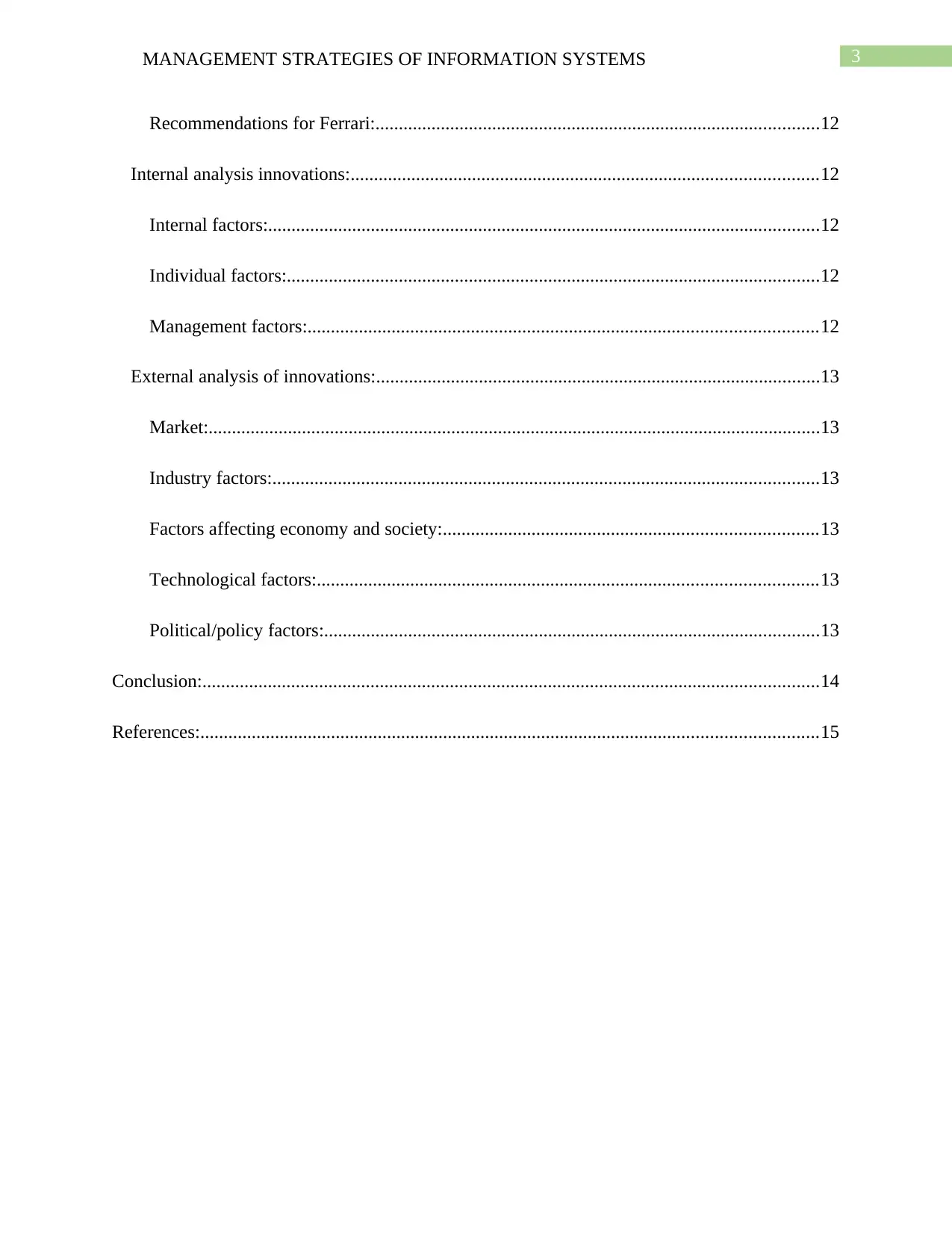
3MANAGEMENT STRATEGIES OF INFORMATION SYSTEMS
Recommendations for Ferrari:...............................................................................................12
Internal analysis innovations:....................................................................................................12
Internal factors:......................................................................................................................12
Individual factors:..................................................................................................................12
Management factors:.............................................................................................................12
External analysis of innovations:...............................................................................................13
Market:...................................................................................................................................13
Industry factors:.....................................................................................................................13
Factors affecting economy and society:................................................................................13
Technological factors:...........................................................................................................13
Political/policy factors:..........................................................................................................13
Conclusion:....................................................................................................................................14
References:....................................................................................................................................15
Recommendations for Ferrari:...............................................................................................12
Internal analysis innovations:....................................................................................................12
Internal factors:......................................................................................................................12
Individual factors:..................................................................................................................12
Management factors:.............................................................................................................12
External analysis of innovations:...............................................................................................13
Market:...................................................................................................................................13
Industry factors:.....................................................................................................................13
Factors affecting economy and society:................................................................................13
Technological factors:...........................................................................................................13
Political/policy factors:..........................................................................................................13
Conclusion:....................................................................................................................................14
References:....................................................................................................................................15
Secure Best Marks with AI Grader
Need help grading? Try our AI Grader for instant feedback on your assignments.
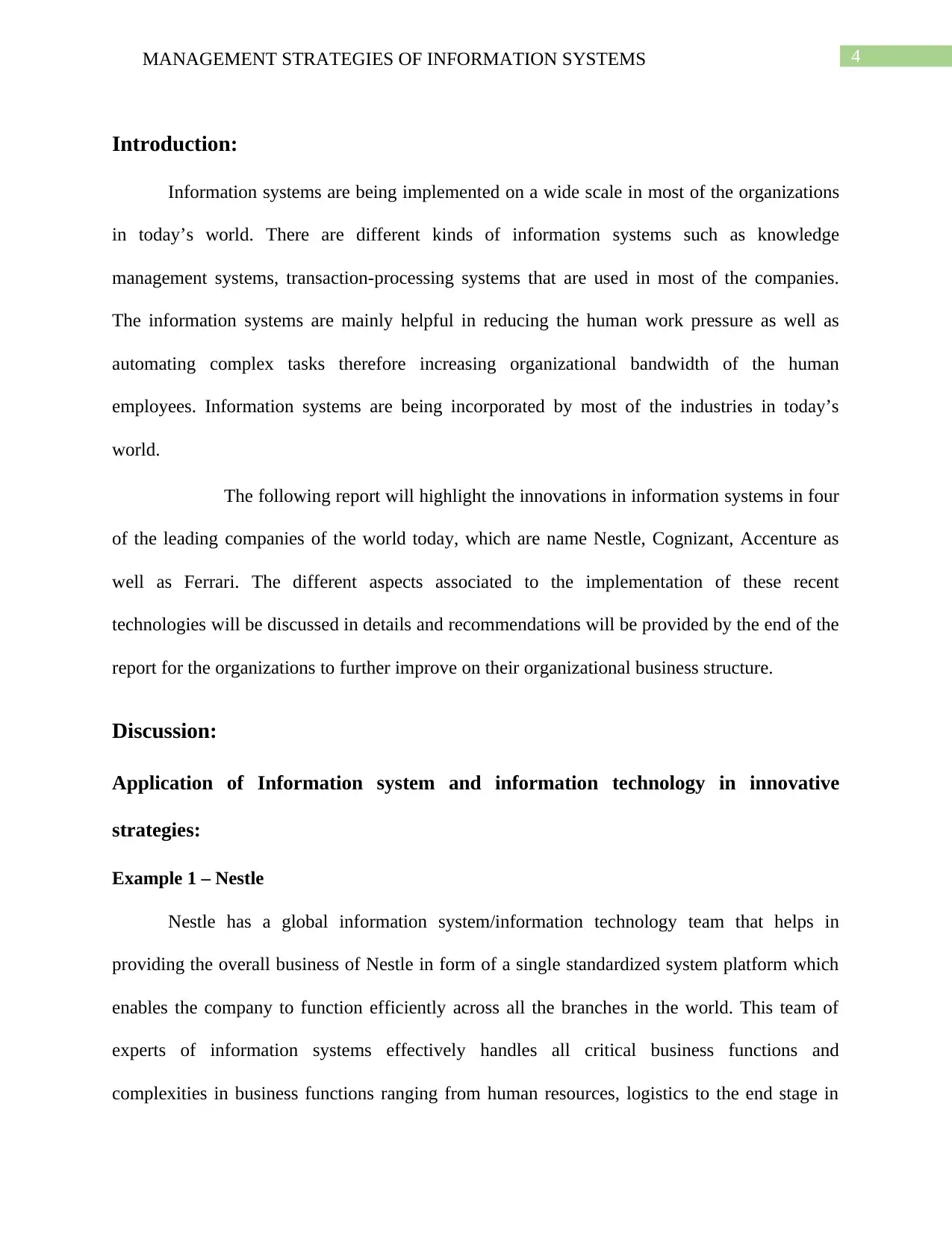
4MANAGEMENT STRATEGIES OF INFORMATION SYSTEMS
Introduction:
Information systems are being implemented on a wide scale in most of the organizations
in today’s world. There are different kinds of information systems such as knowledge
management systems, transaction-processing systems that are used in most of the companies.
The information systems are mainly helpful in reducing the human work pressure as well as
automating complex tasks therefore increasing organizational bandwidth of the human
employees. Information systems are being incorporated by most of the industries in today’s
world.
The following report will highlight the innovations in information systems in four
of the leading companies of the world today, which are name Nestle, Cognizant, Accenture as
well as Ferrari. The different aspects associated to the implementation of these recent
technologies will be discussed in details and recommendations will be provided by the end of the
report for the organizations to further improve on their organizational business structure.
Discussion:
Application of Information system and information technology in innovative
strategies:
Example 1 – Nestle
Nestle has a global information system/information technology team that helps in
providing the overall business of Nestle in form of a single standardized system platform which
enables the company to function efficiently across all the branches in the world. This team of
experts of information systems effectively handles all critical business functions and
complexities in business functions ranging from human resources, logistics to the end stage in
Introduction:
Information systems are being implemented on a wide scale in most of the organizations
in today’s world. There are different kinds of information systems such as knowledge
management systems, transaction-processing systems that are used in most of the companies.
The information systems are mainly helpful in reducing the human work pressure as well as
automating complex tasks therefore increasing organizational bandwidth of the human
employees. Information systems are being incorporated by most of the industries in today’s
world.
The following report will highlight the innovations in information systems in four
of the leading companies of the world today, which are name Nestle, Cognizant, Accenture as
well as Ferrari. The different aspects associated to the implementation of these recent
technologies will be discussed in details and recommendations will be provided by the end of the
report for the organizations to further improve on their organizational business structure.
Discussion:
Application of Information system and information technology in innovative
strategies:
Example 1 – Nestle
Nestle has a global information system/information technology team that helps in
providing the overall business of Nestle in form of a single standardized system platform which
enables the company to function efficiently across all the branches in the world. This team of
experts of information systems effectively handles all critical business functions and
complexities in business functions ranging from human resources, logistics to the end stage in
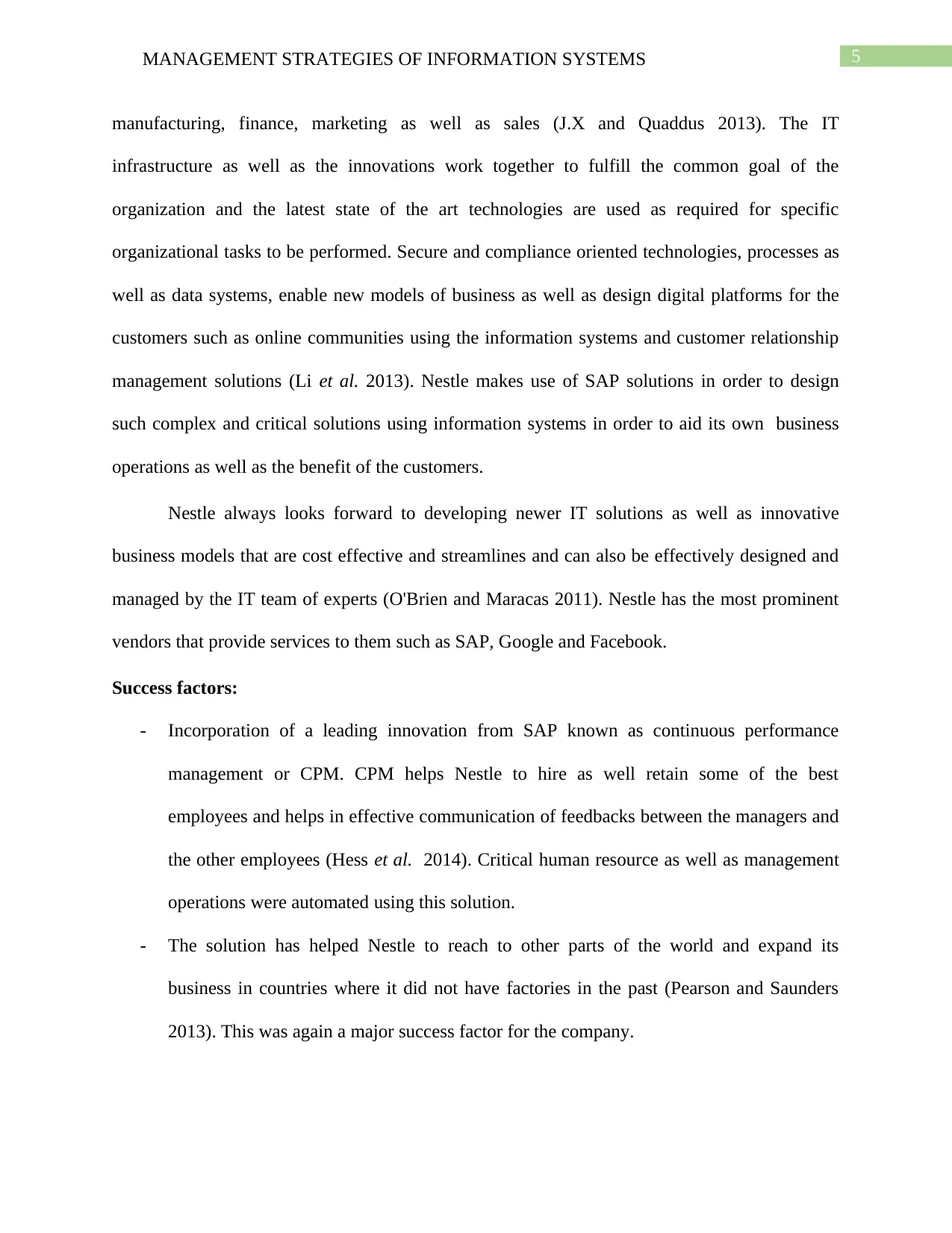
5MANAGEMENT STRATEGIES OF INFORMATION SYSTEMS
manufacturing, finance, marketing as well as sales (J.X and Quaddus 2013). The IT
infrastructure as well as the innovations work together to fulfill the common goal of the
organization and the latest state of the art technologies are used as required for specific
organizational tasks to be performed. Secure and compliance oriented technologies, processes as
well as data systems, enable new models of business as well as design digital platforms for the
customers such as online communities using the information systems and customer relationship
management solutions (Li et al. 2013). Nestle makes use of SAP solutions in order to design
such complex and critical solutions using information systems in order to aid its own business
operations as well as the benefit of the customers.
Nestle always looks forward to developing newer IT solutions as well as innovative
business models that are cost effective and streamlines and can also be effectively designed and
managed by the IT team of experts (O'Brien and Maracas 2011). Nestle has the most prominent
vendors that provide services to them such as SAP, Google and Facebook.
Success factors:
- Incorporation of a leading innovation from SAP known as continuous performance
management or CPM. CPM helps Nestle to hire as well retain some of the best
employees and helps in effective communication of feedbacks between the managers and
the other employees (Hess et al. 2014). Critical human resource as well as management
operations were automated using this solution.
- The solution has helped Nestle to reach to other parts of the world and expand its
business in countries where it did not have factories in the past (Pearson and Saunders
2013). This was again a major success factor for the company.
manufacturing, finance, marketing as well as sales (J.X and Quaddus 2013). The IT
infrastructure as well as the innovations work together to fulfill the common goal of the
organization and the latest state of the art technologies are used as required for specific
organizational tasks to be performed. Secure and compliance oriented technologies, processes as
well as data systems, enable new models of business as well as design digital platforms for the
customers such as online communities using the information systems and customer relationship
management solutions (Li et al. 2013). Nestle makes use of SAP solutions in order to design
such complex and critical solutions using information systems in order to aid its own business
operations as well as the benefit of the customers.
Nestle always looks forward to developing newer IT solutions as well as innovative
business models that are cost effective and streamlines and can also be effectively designed and
managed by the IT team of experts (O'Brien and Maracas 2011). Nestle has the most prominent
vendors that provide services to them such as SAP, Google and Facebook.
Success factors:
- Incorporation of a leading innovation from SAP known as continuous performance
management or CPM. CPM helps Nestle to hire as well retain some of the best
employees and helps in effective communication of feedbacks between the managers and
the other employees (Hess et al. 2014). Critical human resource as well as management
operations were automated using this solution.
- The solution has helped Nestle to reach to other parts of the world and expand its
business in countries where it did not have factories in the past (Pearson and Saunders
2013). This was again a major success factor for the company.
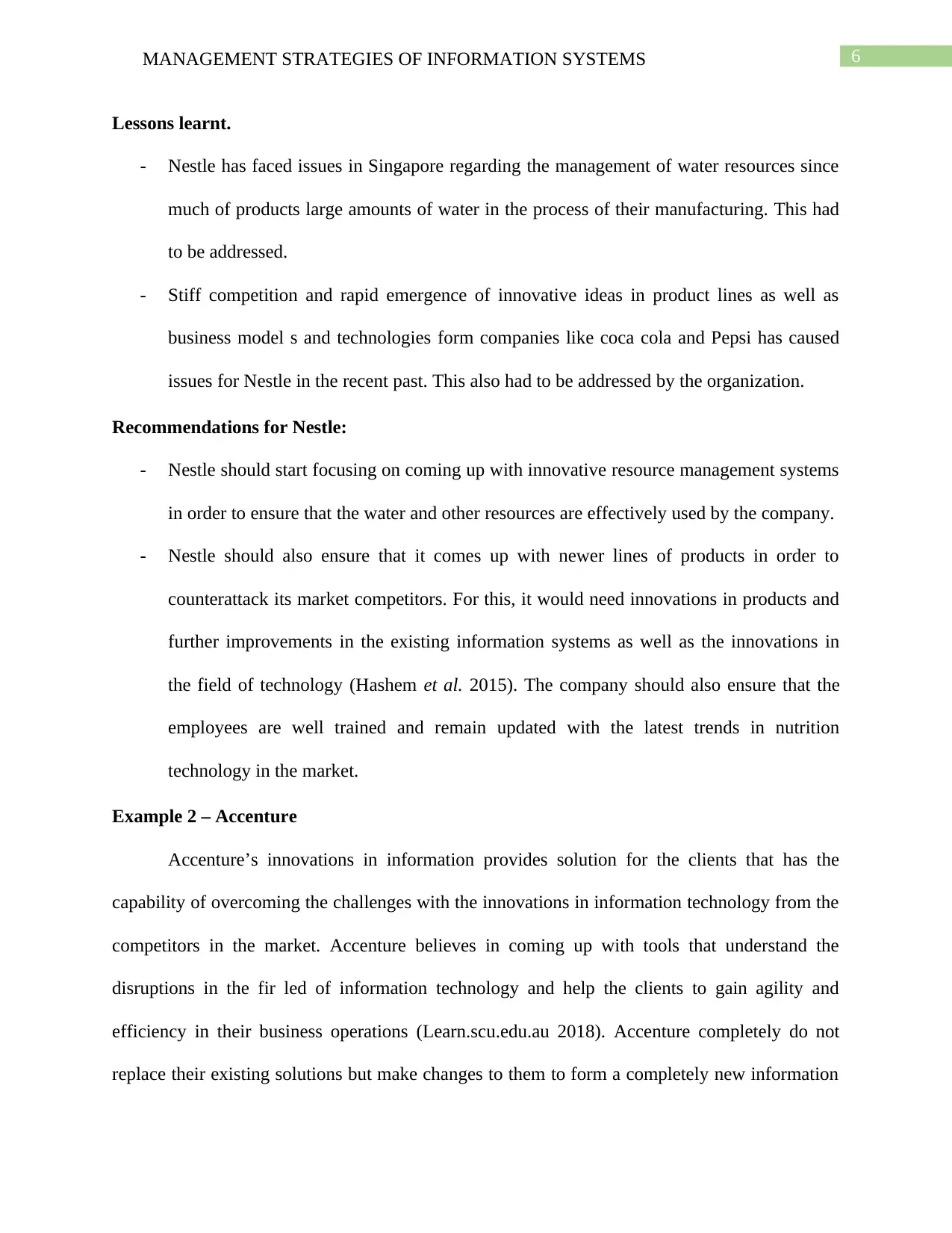
6MANAGEMENT STRATEGIES OF INFORMATION SYSTEMS
Lessons learnt.
- Nestle has faced issues in Singapore regarding the management of water resources since
much of products large amounts of water in the process of their manufacturing. This had
to be addressed.
- Stiff competition and rapid emergence of innovative ideas in product lines as well as
business model s and technologies form companies like coca cola and Pepsi has caused
issues for Nestle in the recent past. This also had to be addressed by the organization.
Recommendations for Nestle:
- Nestle should start focusing on coming up with innovative resource management systems
in order to ensure that the water and other resources are effectively used by the company.
- Nestle should also ensure that it comes up with newer lines of products in order to
counterattack its market competitors. For this, it would need innovations in products and
further improvements in the existing information systems as well as the innovations in
the field of technology (Hashem et al. 2015). The company should also ensure that the
employees are well trained and remain updated with the latest trends in nutrition
technology in the market.
Example 2 – Accenture
Accenture’s innovations in information provides solution for the clients that has the
capability of overcoming the challenges with the innovations in information technology from the
competitors in the market. Accenture believes in coming up with tools that understand the
disruptions in the fir led of information technology and help the clients to gain agility and
efficiency in their business operations (Learn.scu.edu.au 2018). Accenture completely do not
replace their existing solutions but make changes to them to form a completely new information
Lessons learnt.
- Nestle has faced issues in Singapore regarding the management of water resources since
much of products large amounts of water in the process of their manufacturing. This had
to be addressed.
- Stiff competition and rapid emergence of innovative ideas in product lines as well as
business model s and technologies form companies like coca cola and Pepsi has caused
issues for Nestle in the recent past. This also had to be addressed by the organization.
Recommendations for Nestle:
- Nestle should start focusing on coming up with innovative resource management systems
in order to ensure that the water and other resources are effectively used by the company.
- Nestle should also ensure that it comes up with newer lines of products in order to
counterattack its market competitors. For this, it would need innovations in products and
further improvements in the existing information systems as well as the innovations in
the field of technology (Hashem et al. 2015). The company should also ensure that the
employees are well trained and remain updated with the latest trends in nutrition
technology in the market.
Example 2 – Accenture
Accenture’s innovations in information provides solution for the clients that has the
capability of overcoming the challenges with the innovations in information technology from the
competitors in the market. Accenture believes in coming up with tools that understand the
disruptions in the fir led of information technology and help the clients to gain agility and
efficiency in their business operations (Learn.scu.edu.au 2018). Accenture completely do not
replace their existing solutions but make changes to them to form a completely new information
Paraphrase This Document
Need a fresh take? Get an instant paraphrase of this document with our AI Paraphraser
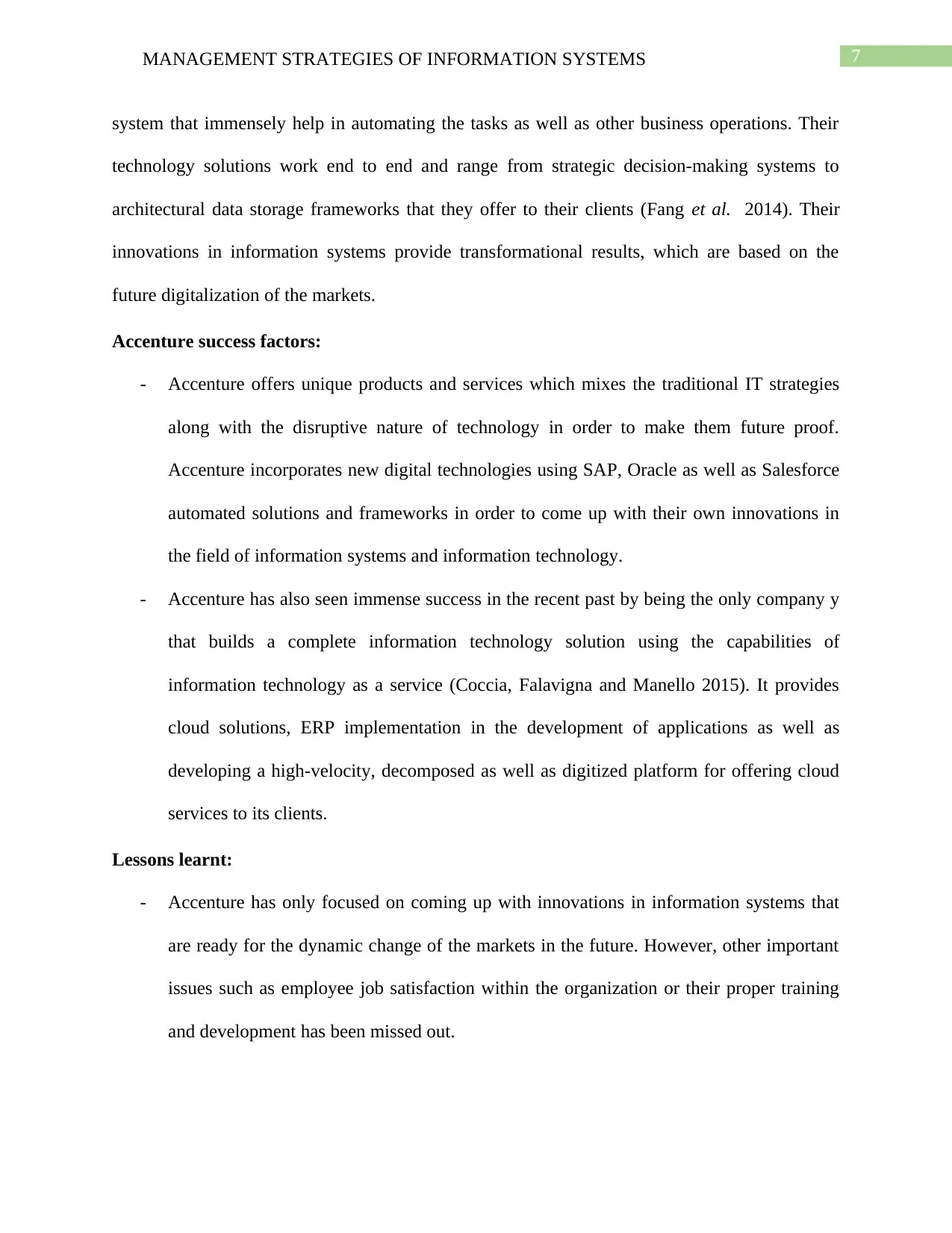
7MANAGEMENT STRATEGIES OF INFORMATION SYSTEMS
system that immensely help in automating the tasks as well as other business operations. Their
technology solutions work end to end and range from strategic decision-making systems to
architectural data storage frameworks that they offer to their clients (Fang et al. 2014). Their
innovations in information systems provide transformational results, which are based on the
future digitalization of the markets.
Accenture success factors:
- Accenture offers unique products and services which mixes the traditional IT strategies
along with the disruptive nature of technology in order to make them future proof.
Accenture incorporates new digital technologies using SAP, Oracle as well as Salesforce
automated solutions and frameworks in order to come up with their own innovations in
the field of information systems and information technology.
- Accenture has also seen immense success in the recent past by being the only company y
that builds a complete information technology solution using the capabilities of
information technology as a service (Coccia, Falavigna and Manello 2015). It provides
cloud solutions, ERP implementation in the development of applications as well as
developing a high-velocity, decomposed as well as digitized platform for offering cloud
services to its clients.
Lessons learnt:
- Accenture has only focused on coming up with innovations in information systems that
are ready for the dynamic change of the markets in the future. However, other important
issues such as employee job satisfaction within the organization or their proper training
and development has been missed out.
system that immensely help in automating the tasks as well as other business operations. Their
technology solutions work end to end and range from strategic decision-making systems to
architectural data storage frameworks that they offer to their clients (Fang et al. 2014). Their
innovations in information systems provide transformational results, which are based on the
future digitalization of the markets.
Accenture success factors:
- Accenture offers unique products and services which mixes the traditional IT strategies
along with the disruptive nature of technology in order to make them future proof.
Accenture incorporates new digital technologies using SAP, Oracle as well as Salesforce
automated solutions and frameworks in order to come up with their own innovations in
the field of information systems and information technology.
- Accenture has also seen immense success in the recent past by being the only company y
that builds a complete information technology solution using the capabilities of
information technology as a service (Coccia, Falavigna and Manello 2015). It provides
cloud solutions, ERP implementation in the development of applications as well as
developing a high-velocity, decomposed as well as digitized platform for offering cloud
services to its clients.
Lessons learnt:
- Accenture has only focused on coming up with innovations in information systems that
are ready for the dynamic change of the markets in the future. However, other important
issues such as employee job satisfaction within the organization or their proper training
and development has been missed out.
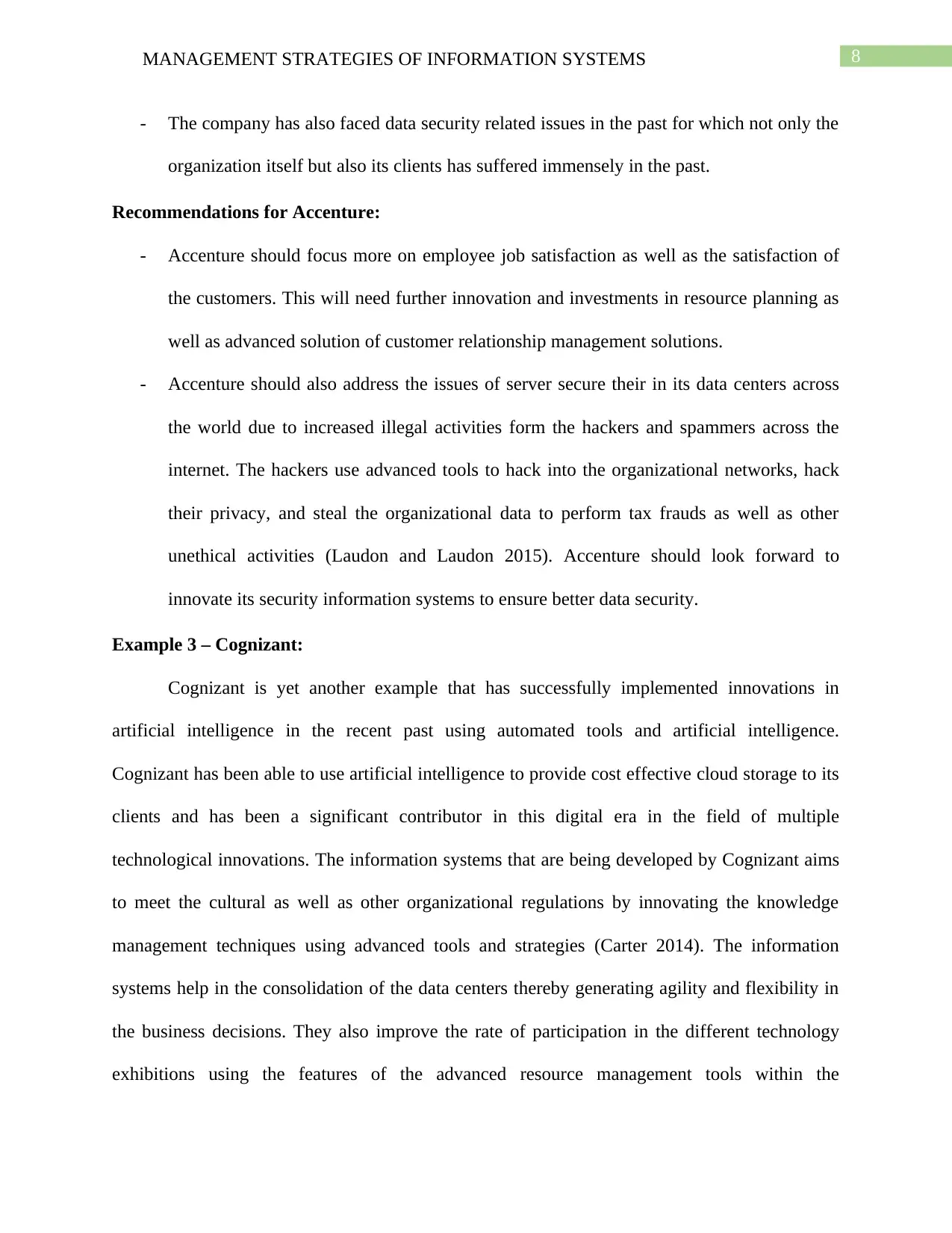
8MANAGEMENT STRATEGIES OF INFORMATION SYSTEMS
- The company has also faced data security related issues in the past for which not only the
organization itself but also its clients has suffered immensely in the past.
Recommendations for Accenture:
- Accenture should focus more on employee job satisfaction as well as the satisfaction of
the customers. This will need further innovation and investments in resource planning as
well as advanced solution of customer relationship management solutions.
- Accenture should also address the issues of server secure their in its data centers across
the world due to increased illegal activities form the hackers and spammers across the
internet. The hackers use advanced tools to hack into the organizational networks, hack
their privacy, and steal the organizational data to perform tax frauds as well as other
unethical activities (Laudon and Laudon 2015). Accenture should look forward to
innovate its security information systems to ensure better data security.
Example 3 – Cognizant:
Cognizant is yet another example that has successfully implemented innovations in
artificial intelligence in the recent past using automated tools and artificial intelligence.
Cognizant has been able to use artificial intelligence to provide cost effective cloud storage to its
clients and has been a significant contributor in this digital era in the field of multiple
technological innovations. The information systems that are being developed by Cognizant aims
to meet the cultural as well as other organizational regulations by innovating the knowledge
management techniques using advanced tools and strategies (Carter 2014). The information
systems help in the consolidation of the data centers thereby generating agility and flexibility in
the business decisions. They also improve the rate of participation in the different technology
exhibitions using the features of the advanced resource management tools within the
- The company has also faced data security related issues in the past for which not only the
organization itself but also its clients has suffered immensely in the past.
Recommendations for Accenture:
- Accenture should focus more on employee job satisfaction as well as the satisfaction of
the customers. This will need further innovation and investments in resource planning as
well as advanced solution of customer relationship management solutions.
- Accenture should also address the issues of server secure their in its data centers across
the world due to increased illegal activities form the hackers and spammers across the
internet. The hackers use advanced tools to hack into the organizational networks, hack
their privacy, and steal the organizational data to perform tax frauds as well as other
unethical activities (Laudon and Laudon 2015). Accenture should look forward to
innovate its security information systems to ensure better data security.
Example 3 – Cognizant:
Cognizant is yet another example that has successfully implemented innovations in
artificial intelligence in the recent past using automated tools and artificial intelligence.
Cognizant has been able to use artificial intelligence to provide cost effective cloud storage to its
clients and has been a significant contributor in this digital era in the field of multiple
technological innovations. The information systems that are being developed by Cognizant aims
to meet the cultural as well as other organizational regulations by innovating the knowledge
management techniques using advanced tools and strategies (Carter 2014). The information
systems help in the consolidation of the data centers thereby generating agility and flexibility in
the business decisions. They also improve the rate of participation in the different technology
exhibitions using the features of the advanced resource management tools within the
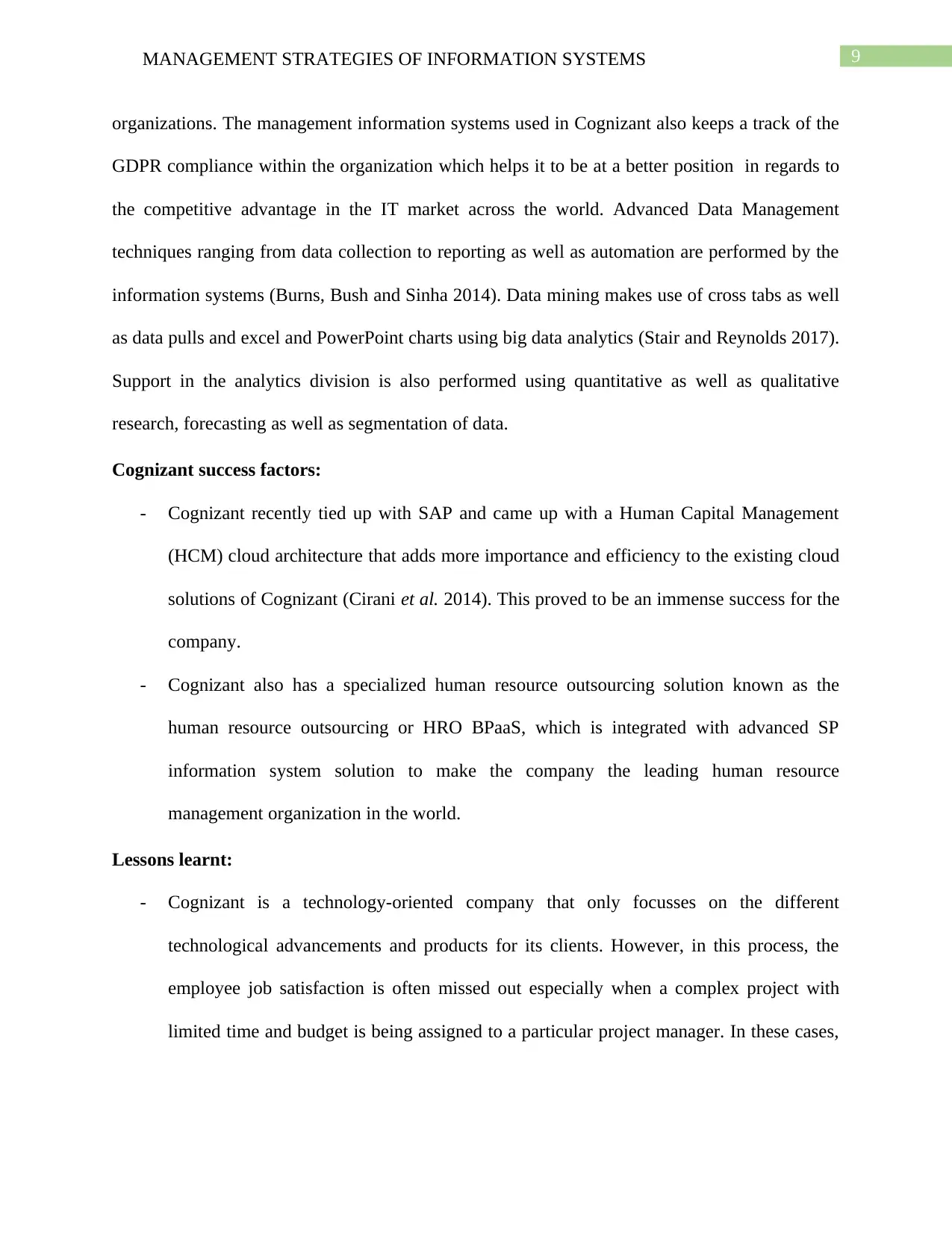
9MANAGEMENT STRATEGIES OF INFORMATION SYSTEMS
organizations. The management information systems used in Cognizant also keeps a track of the
GDPR compliance within the organization which helps it to be at a better position in regards to
the competitive advantage in the IT market across the world. Advanced Data Management
techniques ranging from data collection to reporting as well as automation are performed by the
information systems (Burns, Bush and Sinha 2014). Data mining makes use of cross tabs as well
as data pulls and excel and PowerPoint charts using big data analytics (Stair and Reynolds 2017).
Support in the analytics division is also performed using quantitative as well as qualitative
research, forecasting as well as segmentation of data.
Cognizant success factors:
- Cognizant recently tied up with SAP and came up with a Human Capital Management
(HCM) cloud architecture that adds more importance and efficiency to the existing cloud
solutions of Cognizant (Cirani et al. 2014). This proved to be an immense success for the
company.
- Cognizant also has a specialized human resource outsourcing solution known as the
human resource outsourcing or HRO BPaaS, which is integrated with advanced SP
information system solution to make the company the leading human resource
management organization in the world.
Lessons learnt:
- Cognizant is a technology-oriented company that only focusses on the different
technological advancements and products for its clients. However, in this process, the
employee job satisfaction is often missed out especially when a complex project with
limited time and budget is being assigned to a particular project manager. In these cases,
organizations. The management information systems used in Cognizant also keeps a track of the
GDPR compliance within the organization which helps it to be at a better position in regards to
the competitive advantage in the IT market across the world. Advanced Data Management
techniques ranging from data collection to reporting as well as automation are performed by the
information systems (Burns, Bush and Sinha 2014). Data mining makes use of cross tabs as well
as data pulls and excel and PowerPoint charts using big data analytics (Stair and Reynolds 2017).
Support in the analytics division is also performed using quantitative as well as qualitative
research, forecasting as well as segmentation of data.
Cognizant success factors:
- Cognizant recently tied up with SAP and came up with a Human Capital Management
(HCM) cloud architecture that adds more importance and efficiency to the existing cloud
solutions of Cognizant (Cirani et al. 2014). This proved to be an immense success for the
company.
- Cognizant also has a specialized human resource outsourcing solution known as the
human resource outsourcing or HRO BPaaS, which is integrated with advanced SP
information system solution to make the company the leading human resource
management organization in the world.
Lessons learnt:
- Cognizant is a technology-oriented company that only focusses on the different
technological advancements and products for its clients. However, in this process, the
employee job satisfaction is often missed out especially when a complex project with
limited time and budget is being assigned to a particular project manager. In these cases,
Secure Best Marks with AI Grader
Need help grading? Try our AI Grader for instant feedback on your assignments.
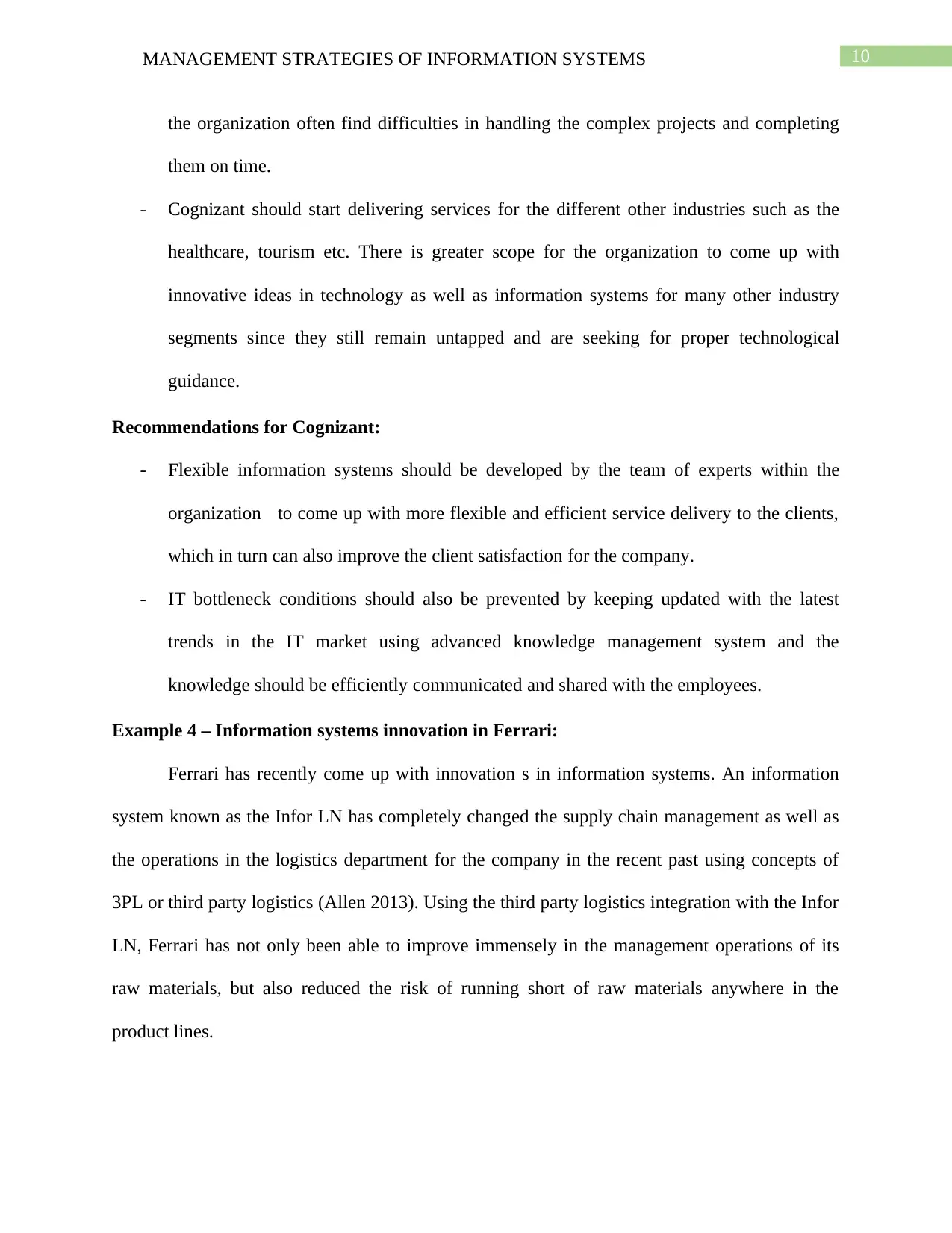
10MANAGEMENT STRATEGIES OF INFORMATION SYSTEMS
the organization often find difficulties in handling the complex projects and completing
them on time.
- Cognizant should start delivering services for the different other industries such as the
healthcare, tourism etc. There is greater scope for the organization to come up with
innovative ideas in technology as well as information systems for many other industry
segments since they still remain untapped and are seeking for proper technological
guidance.
Recommendations for Cognizant:
- Flexible information systems should be developed by the team of experts within the
organization to come up with more flexible and efficient service delivery to the clients,
which in turn can also improve the client satisfaction for the company.
- IT bottleneck conditions should also be prevented by keeping updated with the latest
trends in the IT market using advanced knowledge management system and the
knowledge should be efficiently communicated and shared with the employees.
Example 4 – Information systems innovation in Ferrari:
Ferrari has recently come up with innovation s in information systems. An information
system known as the Infor LN has completely changed the supply chain management as well as
the operations in the logistics department for the company in the recent past using concepts of
3PL or third party logistics (Allen 2013). Using the third party logistics integration with the Infor
LN, Ferrari has not only been able to improve immensely in the management operations of its
raw materials, but also reduced the risk of running short of raw materials anywhere in the
product lines.
the organization often find difficulties in handling the complex projects and completing
them on time.
- Cognizant should start delivering services for the different other industries such as the
healthcare, tourism etc. There is greater scope for the organization to come up with
innovative ideas in technology as well as information systems for many other industry
segments since they still remain untapped and are seeking for proper technological
guidance.
Recommendations for Cognizant:
- Flexible information systems should be developed by the team of experts within the
organization to come up with more flexible and efficient service delivery to the clients,
which in turn can also improve the client satisfaction for the company.
- IT bottleneck conditions should also be prevented by keeping updated with the latest
trends in the IT market using advanced knowledge management system and the
knowledge should be efficiently communicated and shared with the employees.
Example 4 – Information systems innovation in Ferrari:
Ferrari has recently come up with innovation s in information systems. An information
system known as the Infor LN has completely changed the supply chain management as well as
the operations in the logistics department for the company in the recent past using concepts of
3PL or third party logistics (Allen 2013). Using the third party logistics integration with the Infor
LN, Ferrari has not only been able to improve immensely in the management operations of its
raw materials, but also reduced the risk of running short of raw materials anywhere in the
product lines.
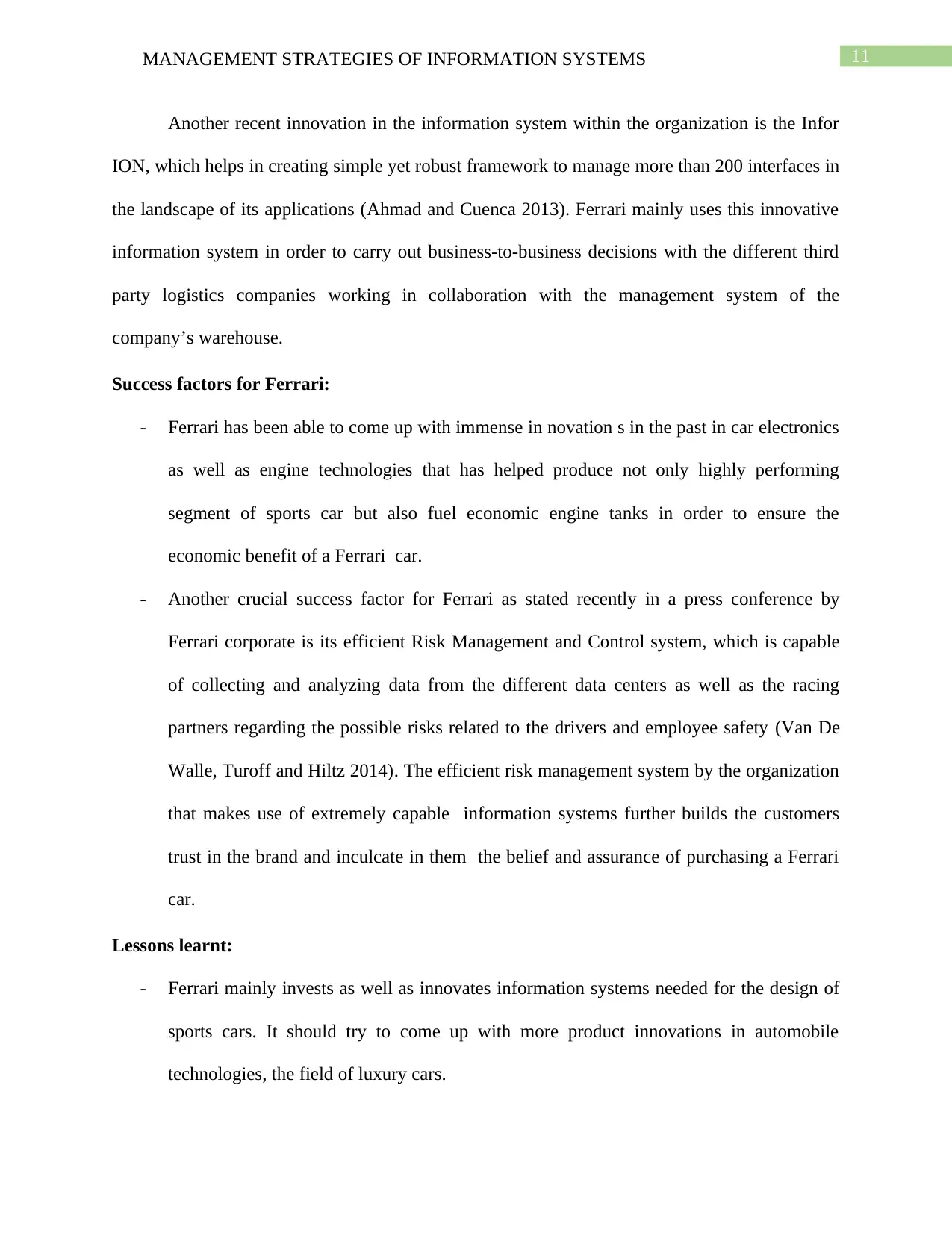
11MANAGEMENT STRATEGIES OF INFORMATION SYSTEMS
Another recent innovation in the information system within the organization is the Infor
ION, which helps in creating simple yet robust framework to manage more than 200 interfaces in
the landscape of its applications (Ahmad and Cuenca 2013). Ferrari mainly uses this innovative
information system in order to carry out business-to-business decisions with the different third
party logistics companies working in collaboration with the management system of the
company’s warehouse.
Success factors for Ferrari:
- Ferrari has been able to come up with immense in novation s in the past in car electronics
as well as engine technologies that has helped produce not only highly performing
segment of sports car but also fuel economic engine tanks in order to ensure the
economic benefit of a Ferrari car.
- Another crucial success factor for Ferrari as stated recently in a press conference by
Ferrari corporate is its efficient Risk Management and Control system, which is capable
of collecting and analyzing data from the different data centers as well as the racing
partners regarding the possible risks related to the drivers and employee safety (Van De
Walle, Turoff and Hiltz 2014). The efficient risk management system by the organization
that makes use of extremely capable information systems further builds the customers
trust in the brand and inculcate in them the belief and assurance of purchasing a Ferrari
car.
Lessons learnt:
- Ferrari mainly invests as well as innovates information systems needed for the design of
sports cars. It should try to come up with more product innovations in automobile
technologies, the field of luxury cars.
Another recent innovation in the information system within the organization is the Infor
ION, which helps in creating simple yet robust framework to manage more than 200 interfaces in
the landscape of its applications (Ahmad and Cuenca 2013). Ferrari mainly uses this innovative
information system in order to carry out business-to-business decisions with the different third
party logistics companies working in collaboration with the management system of the
company’s warehouse.
Success factors for Ferrari:
- Ferrari has been able to come up with immense in novation s in the past in car electronics
as well as engine technologies that has helped produce not only highly performing
segment of sports car but also fuel economic engine tanks in order to ensure the
economic benefit of a Ferrari car.
- Another crucial success factor for Ferrari as stated recently in a press conference by
Ferrari corporate is its efficient Risk Management and Control system, which is capable
of collecting and analyzing data from the different data centers as well as the racing
partners regarding the possible risks related to the drivers and employee safety (Van De
Walle, Turoff and Hiltz 2014). The efficient risk management system by the organization
that makes use of extremely capable information systems further builds the customers
trust in the brand and inculcate in them the belief and assurance of purchasing a Ferrari
car.
Lessons learnt:
- Ferrari mainly invests as well as innovates information systems needed for the design of
sports cars. It should try to come up with more product innovations in automobile
technologies, the field of luxury cars.
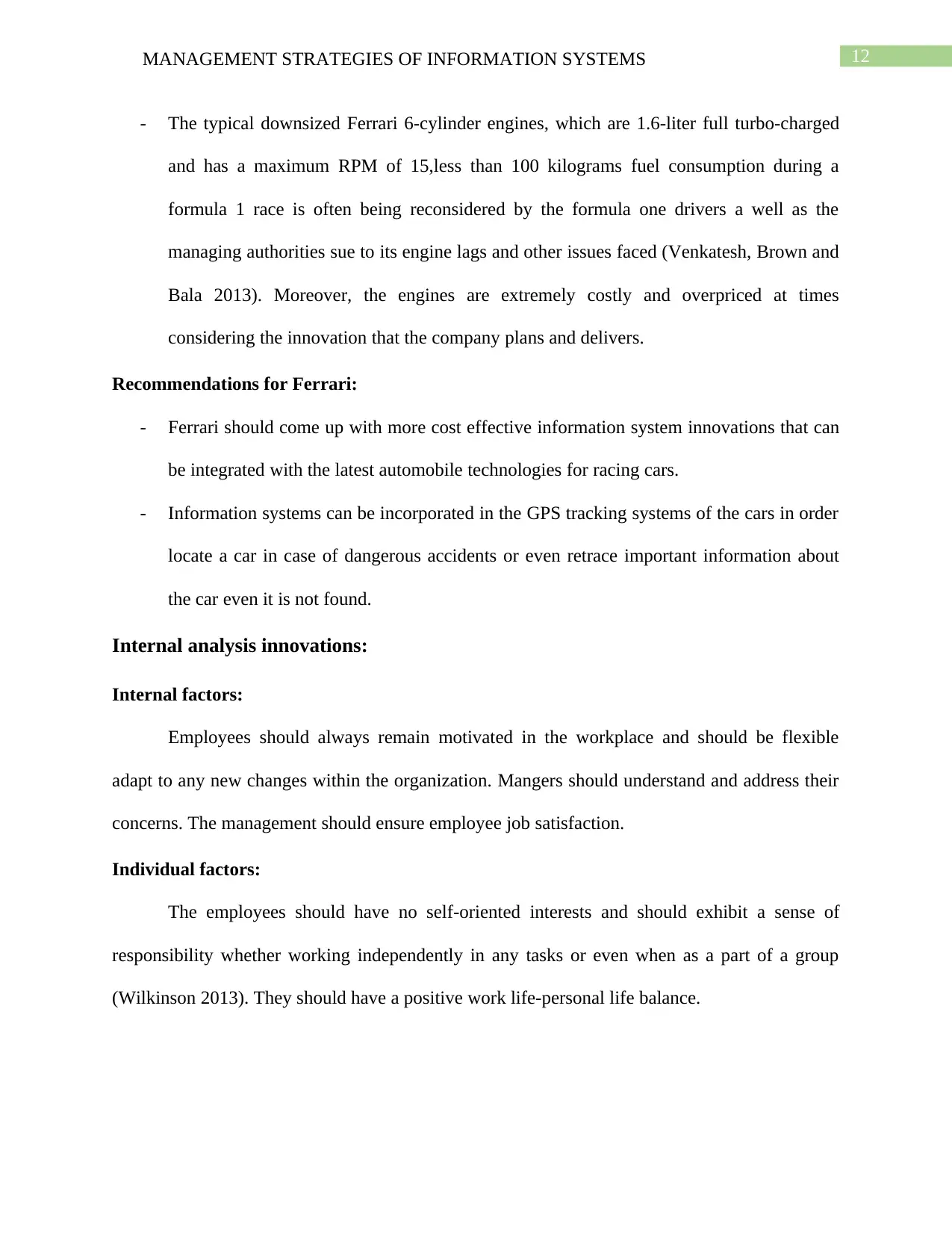
12MANAGEMENT STRATEGIES OF INFORMATION SYSTEMS
- The typical downsized Ferrari 6-cylinder engines, which are 1.6-liter full turbo-charged
and has a maximum RPM of 15,less than 100 kilograms fuel consumption during a
formula 1 race is often being reconsidered by the formula one drivers a well as the
managing authorities sue to its engine lags and other issues faced (Venkatesh, Brown and
Bala 2013). Moreover, the engines are extremely costly and overpriced at times
considering the innovation that the company plans and delivers.
Recommendations for Ferrari:
- Ferrari should come up with more cost effective information system innovations that can
be integrated with the latest automobile technologies for racing cars.
- Information systems can be incorporated in the GPS tracking systems of the cars in order
locate a car in case of dangerous accidents or even retrace important information about
the car even it is not found.
Internal analysis innovations:
Internal factors:
Employees should always remain motivated in the workplace and should be flexible
adapt to any new changes within the organization. Mangers should understand and address their
concerns. The management should ensure employee job satisfaction.
Individual factors:
The employees should have no self-oriented interests and should exhibit a sense of
responsibility whether working independently in any tasks or even when as a part of a group
(Wilkinson 2013). They should have a positive work life-personal life balance.
- The typical downsized Ferrari 6-cylinder engines, which are 1.6-liter full turbo-charged
and has a maximum RPM of 15,less than 100 kilograms fuel consumption during a
formula 1 race is often being reconsidered by the formula one drivers a well as the
managing authorities sue to its engine lags and other issues faced (Venkatesh, Brown and
Bala 2013). Moreover, the engines are extremely costly and overpriced at times
considering the innovation that the company plans and delivers.
Recommendations for Ferrari:
- Ferrari should come up with more cost effective information system innovations that can
be integrated with the latest automobile technologies for racing cars.
- Information systems can be incorporated in the GPS tracking systems of the cars in order
locate a car in case of dangerous accidents or even retrace important information about
the car even it is not found.
Internal analysis innovations:
Internal factors:
Employees should always remain motivated in the workplace and should be flexible
adapt to any new changes within the organization. Mangers should understand and address their
concerns. The management should ensure employee job satisfaction.
Individual factors:
The employees should have no self-oriented interests and should exhibit a sense of
responsibility whether working independently in any tasks or even when as a part of a group
(Wilkinson 2013). They should have a positive work life-personal life balance.
Paraphrase This Document
Need a fresh take? Get an instant paraphrase of this document with our AI Paraphraser
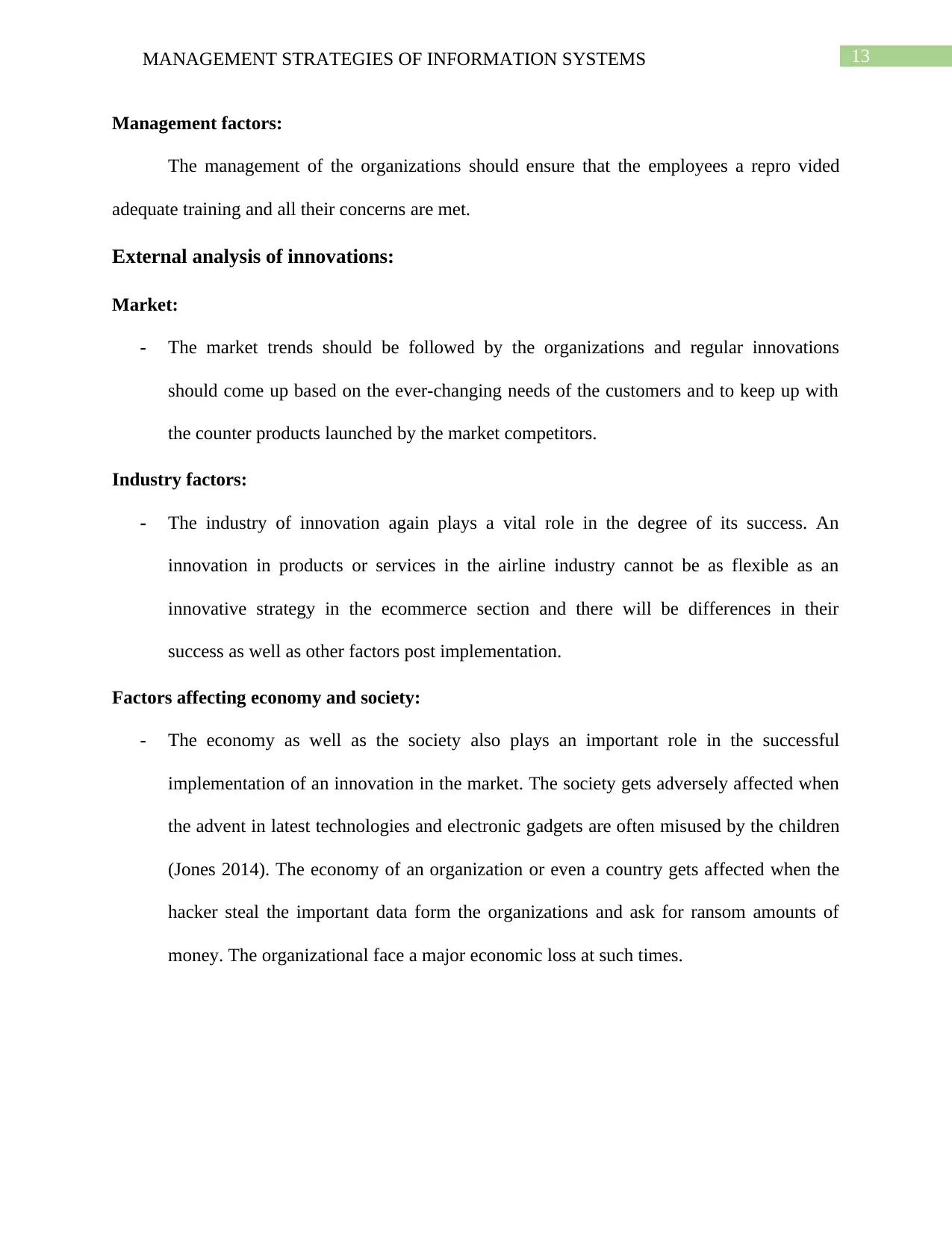
13MANAGEMENT STRATEGIES OF INFORMATION SYSTEMS
Management factors:
The management of the organizations should ensure that the employees a repro vided
adequate training and all their concerns are met.
External analysis of innovations:
Market:
- The market trends should be followed by the organizations and regular innovations
should come up based on the ever-changing needs of the customers and to keep up with
the counter products launched by the market competitors.
Industry factors:
- The industry of innovation again plays a vital role in the degree of its success. An
innovation in products or services in the airline industry cannot be as flexible as an
innovative strategy in the ecommerce section and there will be differences in their
success as well as other factors post implementation.
Factors affecting economy and society:
- The economy as well as the society also plays an important role in the successful
implementation of an innovation in the market. The society gets adversely affected when
the advent in latest technologies and electronic gadgets are often misused by the children
(Jones 2014). The economy of an organization or even a country gets affected when the
hacker steal the important data form the organizations and ask for ransom amounts of
money. The organizational face a major economic loss at such times.
Management factors:
The management of the organizations should ensure that the employees a repro vided
adequate training and all their concerns are met.
External analysis of innovations:
Market:
- The market trends should be followed by the organizations and regular innovations
should come up based on the ever-changing needs of the customers and to keep up with
the counter products launched by the market competitors.
Industry factors:
- The industry of innovation again plays a vital role in the degree of its success. An
innovation in products or services in the airline industry cannot be as flexible as an
innovative strategy in the ecommerce section and there will be differences in their
success as well as other factors post implementation.
Factors affecting economy and society:
- The economy as well as the society also plays an important role in the successful
implementation of an innovation in the market. The society gets adversely affected when
the advent in latest technologies and electronic gadgets are often misused by the children
(Jones 2014). The economy of an organization or even a country gets affected when the
hacker steal the important data form the organizations and ask for ransom amounts of
money. The organizational face a major economic loss at such times.
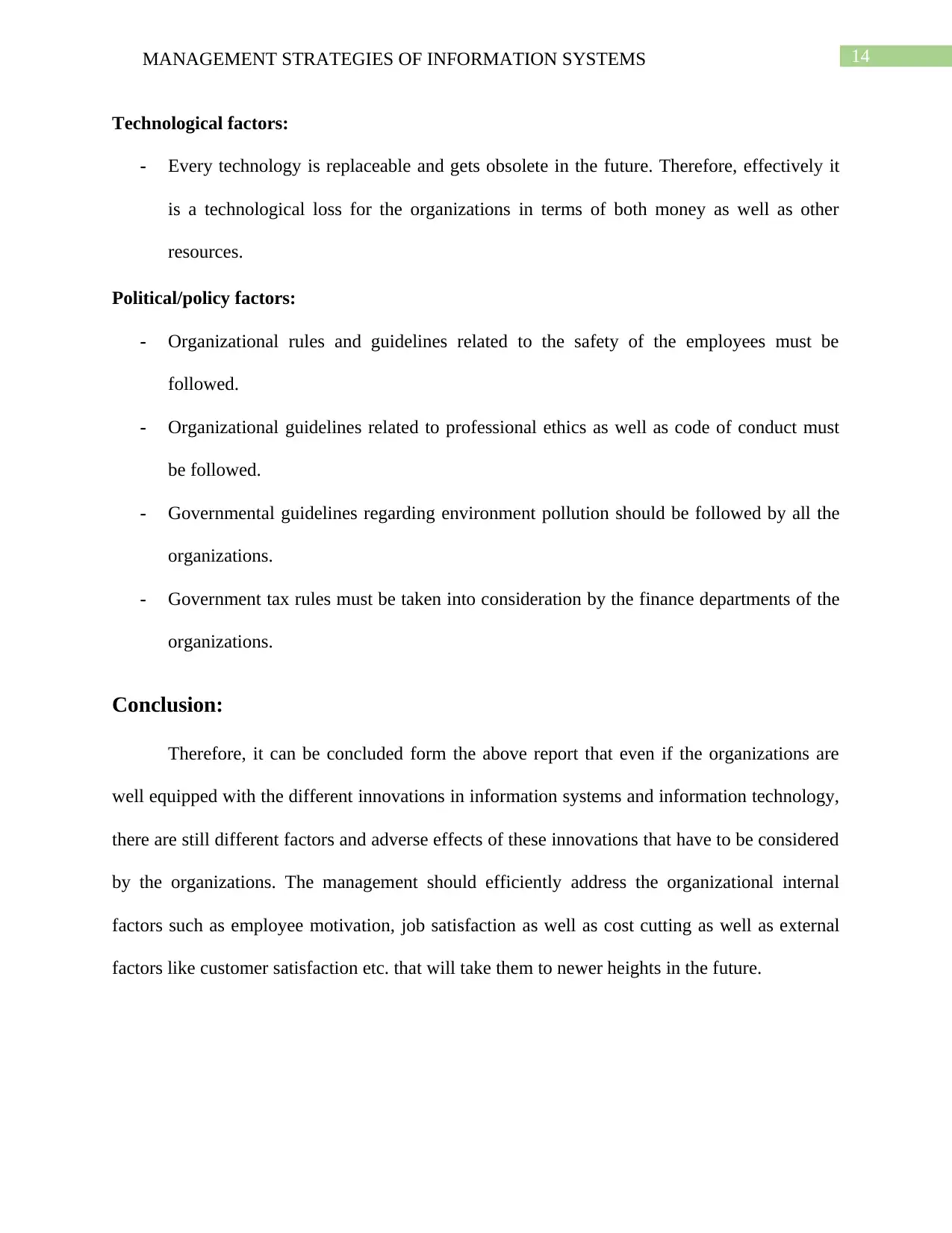
14MANAGEMENT STRATEGIES OF INFORMATION SYSTEMS
Technological factors:
- Every technology is replaceable and gets obsolete in the future. Therefore, effectively it
is a technological loss for the organizations in terms of both money as well as other
resources.
Political/policy factors:
- Organizational rules and guidelines related to the safety of the employees must be
followed.
- Organizational guidelines related to professional ethics as well as code of conduct must
be followed.
- Governmental guidelines regarding environment pollution should be followed by all the
organizations.
- Government tax rules must be taken into consideration by the finance departments of the
organizations.
Conclusion:
Therefore, it can be concluded form the above report that even if the organizations are
well equipped with the different innovations in information systems and information technology,
there are still different factors and adverse effects of these innovations that have to be considered
by the organizations. The management should efficiently address the organizational internal
factors such as employee motivation, job satisfaction as well as cost cutting as well as external
factors like customer satisfaction etc. that will take them to newer heights in the future.
Technological factors:
- Every technology is replaceable and gets obsolete in the future. Therefore, effectively it
is a technological loss for the organizations in terms of both money as well as other
resources.
Political/policy factors:
- Organizational rules and guidelines related to the safety of the employees must be
followed.
- Organizational guidelines related to professional ethics as well as code of conduct must
be followed.
- Governmental guidelines regarding environment pollution should be followed by all the
organizations.
- Government tax rules must be taken into consideration by the finance departments of the
organizations.
Conclusion:
Therefore, it can be concluded form the above report that even if the organizations are
well equipped with the different innovations in information systems and information technology,
there are still different factors and adverse effects of these innovations that have to be considered
by the organizations. The management should efficiently address the organizational internal
factors such as employee motivation, job satisfaction as well as cost cutting as well as external
factors like customer satisfaction etc. that will take them to newer heights in the future.
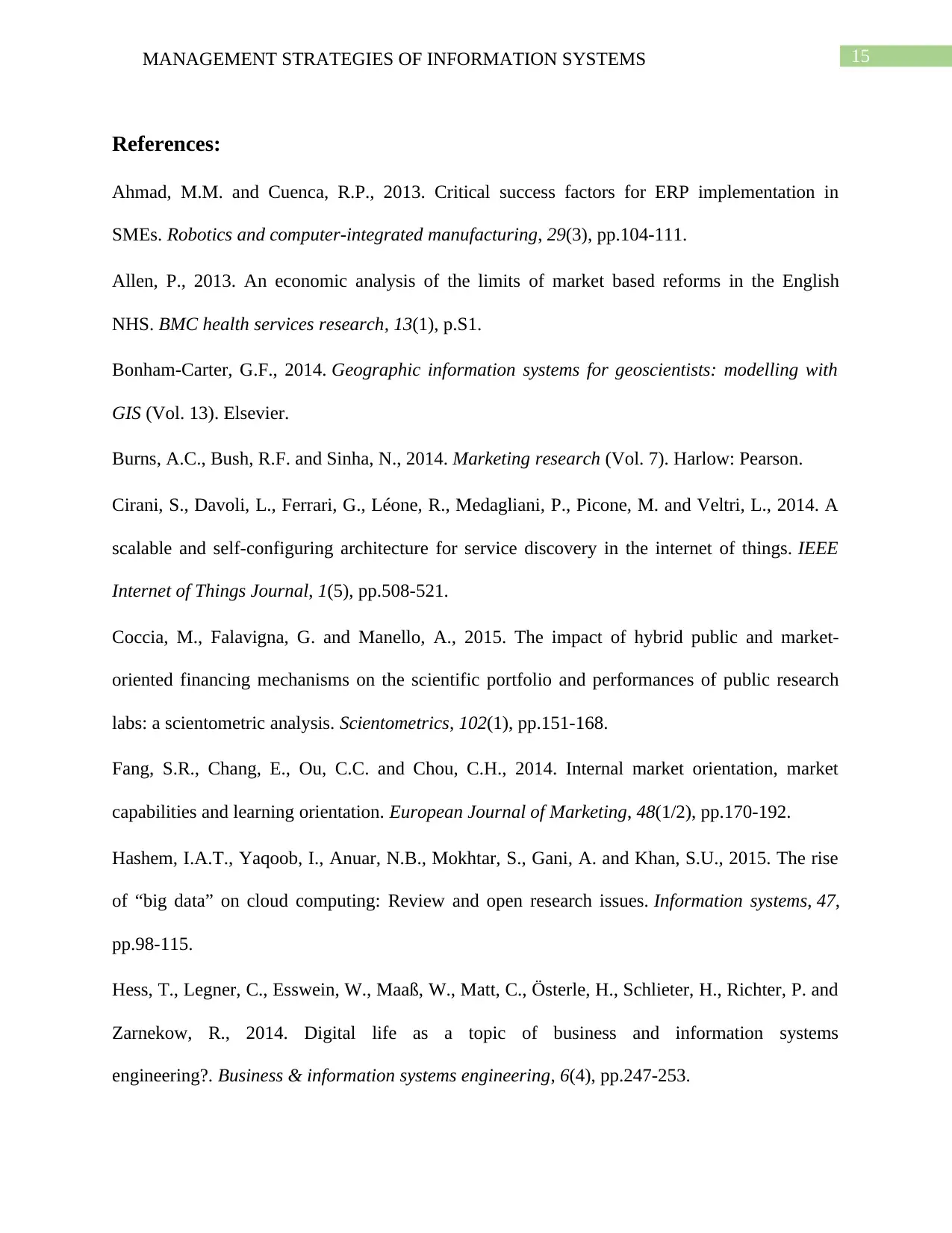
15MANAGEMENT STRATEGIES OF INFORMATION SYSTEMS
References:
Ahmad, M.M. and Cuenca, R.P., 2013. Critical success factors for ERP implementation in
SMEs. Robotics and computer-integrated manufacturing, 29(3), pp.104-111.
Allen, P., 2013. An economic analysis of the limits of market based reforms in the English
NHS. BMC health services research, 13(1), p.S1.
Bonham-Carter, G.F., 2014. Geographic information systems for geoscientists: modelling with
GIS (Vol. 13). Elsevier.
Burns, A.C., Bush, R.F. and Sinha, N., 2014. Marketing research (Vol. 7). Harlow: Pearson.
Cirani, S., Davoli, L., Ferrari, G., Léone, R., Medagliani, P., Picone, M. and Veltri, L., 2014. A
scalable and self-configuring architecture for service discovery in the internet of things. IEEE
Internet of Things Journal, 1(5), pp.508-521.
Coccia, M., Falavigna, G. and Manello, A., 2015. The impact of hybrid public and market-
oriented financing mechanisms on the scientific portfolio and performances of public research
labs: a scientometric analysis. Scientometrics, 102(1), pp.151-168.
Fang, S.R., Chang, E., Ou, C.C. and Chou, C.H., 2014. Internal market orientation, market
capabilities and learning orientation. European Journal of Marketing, 48(1/2), pp.170-192.
Hashem, I.A.T., Yaqoob, I., Anuar, N.B., Mokhtar, S., Gani, A. and Khan, S.U., 2015. The rise
of “big data” on cloud computing: Review and open research issues. Information systems, 47,
pp.98-115.
Hess, T., Legner, C., Esswein, W., Maaß, W., Matt, C., Österle, H., Schlieter, H., Richter, P. and
Zarnekow, R., 2014. Digital life as a topic of business and information systems
engineering?. Business & information systems engineering, 6(4), pp.247-253.
References:
Ahmad, M.M. and Cuenca, R.P., 2013. Critical success factors for ERP implementation in
SMEs. Robotics and computer-integrated manufacturing, 29(3), pp.104-111.
Allen, P., 2013. An economic analysis of the limits of market based reforms in the English
NHS. BMC health services research, 13(1), p.S1.
Bonham-Carter, G.F., 2014. Geographic information systems for geoscientists: modelling with
GIS (Vol. 13). Elsevier.
Burns, A.C., Bush, R.F. and Sinha, N., 2014. Marketing research (Vol. 7). Harlow: Pearson.
Cirani, S., Davoli, L., Ferrari, G., Léone, R., Medagliani, P., Picone, M. and Veltri, L., 2014. A
scalable and self-configuring architecture for service discovery in the internet of things. IEEE
Internet of Things Journal, 1(5), pp.508-521.
Coccia, M., Falavigna, G. and Manello, A., 2015. The impact of hybrid public and market-
oriented financing mechanisms on the scientific portfolio and performances of public research
labs: a scientometric analysis. Scientometrics, 102(1), pp.151-168.
Fang, S.R., Chang, E., Ou, C.C. and Chou, C.H., 2014. Internal market orientation, market
capabilities and learning orientation. European Journal of Marketing, 48(1/2), pp.170-192.
Hashem, I.A.T., Yaqoob, I., Anuar, N.B., Mokhtar, S., Gani, A. and Khan, S.U., 2015. The rise
of “big data” on cloud computing: Review and open research issues. Information systems, 47,
pp.98-115.
Hess, T., Legner, C., Esswein, W., Maaß, W., Matt, C., Österle, H., Schlieter, H., Richter, P. and
Zarnekow, R., 2014. Digital life as a topic of business and information systems
engineering?. Business & information systems engineering, 6(4), pp.247-253.
Secure Best Marks with AI Grader
Need help grading? Try our AI Grader for instant feedback on your assignments.
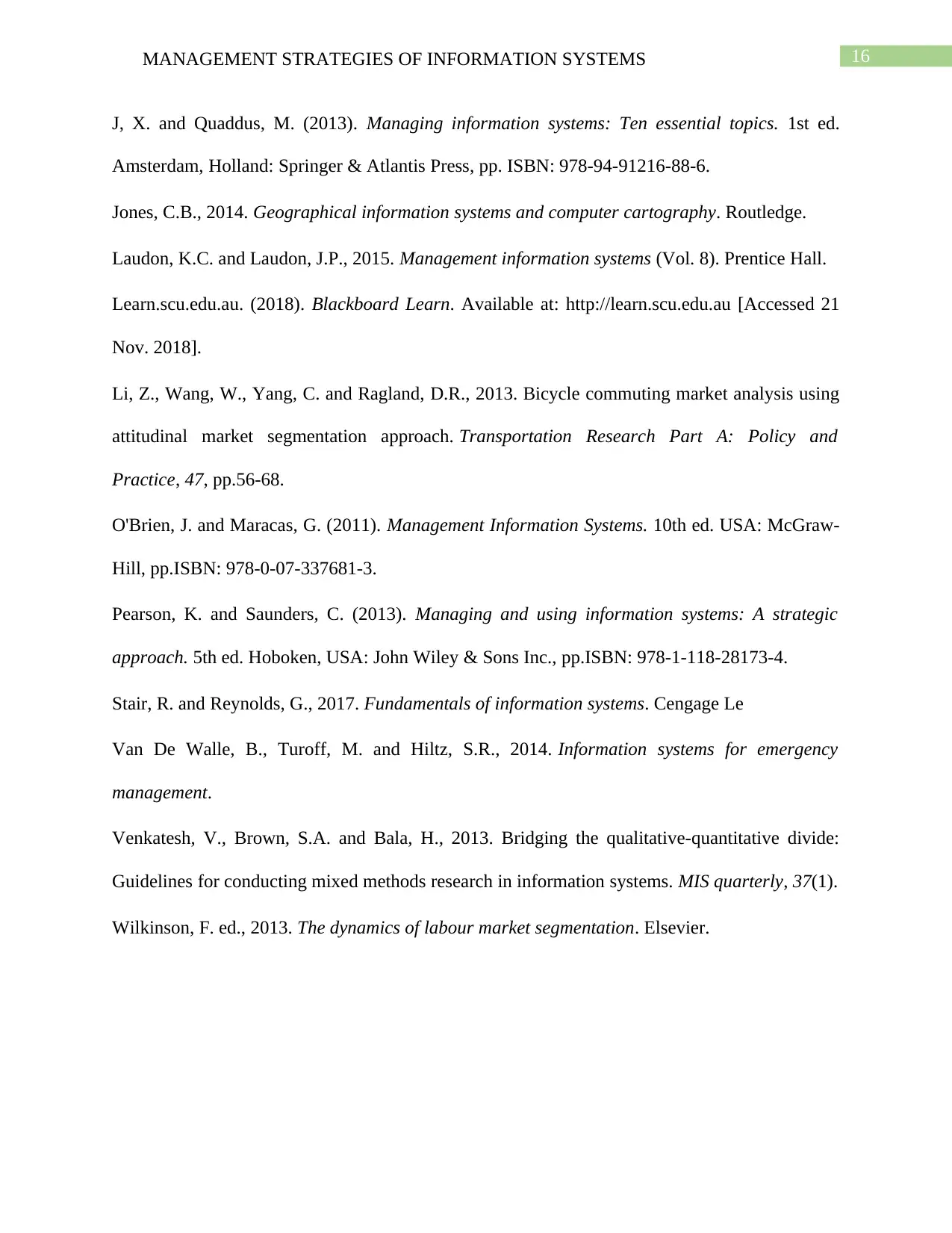
16MANAGEMENT STRATEGIES OF INFORMATION SYSTEMS
J, X. and Quaddus, M. (2013). Managing information systems: Ten essential topics. 1st ed.
Amsterdam, Holland: Springer & Atlantis Press, pp. ISBN: 978-94-91216-88-6.
Jones, C.B., 2014. Geographical information systems and computer cartography. Routledge.
Laudon, K.C. and Laudon, J.P., 2015. Management information systems (Vol. 8). Prentice Hall.
Learn.scu.edu.au. (2018). Blackboard Learn. Available at: http://learn.scu.edu.au [Accessed 21
Nov. 2018].
Li, Z., Wang, W., Yang, C. and Ragland, D.R., 2013. Bicycle commuting market analysis using
attitudinal market segmentation approach. Transportation Research Part A: Policy and
Practice, 47, pp.56-68.
O'Brien, J. and Maracas, G. (2011). Management Information Systems. 10th ed. USA: McGraw-
Hill, pp.ISBN: 978-0-07-337681-3.
Pearson, K. and Saunders, C. (2013). Managing and using information systems: A strategic
approach. 5th ed. Hoboken, USA: John Wiley & Sons Inc., pp.ISBN: 978-1-118-28173-4.
Stair, R. and Reynolds, G., 2017. Fundamentals of information systems. Cengage Le
Van De Walle, B., Turoff, M. and Hiltz, S.R., 2014. Information systems for emergency
management.
Venkatesh, V., Brown, S.A. and Bala, H., 2013. Bridging the qualitative-quantitative divide:
Guidelines for conducting mixed methods research in information systems. MIS quarterly, 37(1).
Wilkinson, F. ed., 2013. The dynamics of labour market segmentation. Elsevier.
J, X. and Quaddus, M. (2013). Managing information systems: Ten essential topics. 1st ed.
Amsterdam, Holland: Springer & Atlantis Press, pp. ISBN: 978-94-91216-88-6.
Jones, C.B., 2014. Geographical information systems and computer cartography. Routledge.
Laudon, K.C. and Laudon, J.P., 2015. Management information systems (Vol. 8). Prentice Hall.
Learn.scu.edu.au. (2018). Blackboard Learn. Available at: http://learn.scu.edu.au [Accessed 21
Nov. 2018].
Li, Z., Wang, W., Yang, C. and Ragland, D.R., 2013. Bicycle commuting market analysis using
attitudinal market segmentation approach. Transportation Research Part A: Policy and
Practice, 47, pp.56-68.
O'Brien, J. and Maracas, G. (2011). Management Information Systems. 10th ed. USA: McGraw-
Hill, pp.ISBN: 978-0-07-337681-3.
Pearson, K. and Saunders, C. (2013). Managing and using information systems: A strategic
approach. 5th ed. Hoboken, USA: John Wiley & Sons Inc., pp.ISBN: 978-1-118-28173-4.
Stair, R. and Reynolds, G., 2017. Fundamentals of information systems. Cengage Le
Van De Walle, B., Turoff, M. and Hiltz, S.R., 2014. Information systems for emergency
management.
Venkatesh, V., Brown, S.A. and Bala, H., 2013. Bridging the qualitative-quantitative divide:
Guidelines for conducting mixed methods research in information systems. MIS quarterly, 37(1).
Wilkinson, F. ed., 2013. The dynamics of labour market segmentation. Elsevier.
1 out of 17
Related Documents
Your All-in-One AI-Powered Toolkit for Academic Success.
+13062052269
info@desklib.com
Available 24*7 on WhatsApp / Email
![[object Object]](/_next/static/media/star-bottom.7253800d.svg)
Unlock your academic potential
© 2024 | Zucol Services PVT LTD | All rights reserved.




